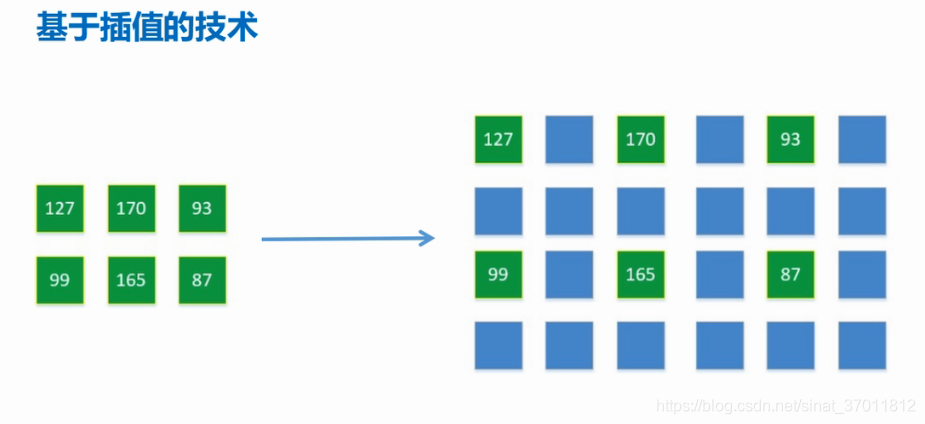揭秘OpenCV图像旋转算法:深入理解旋转原理,提升图像处理效率
发布时间: 2024-08-11 07:17:12 阅读量: 160 订阅数: 21 


opencv图像处理-opencv图像处理算法之图像滤波.zip

# 1. 图像旋转的基础理论
图像旋转是一种图像变换操作,它将图像围绕一个特定点或轴旋转一定角度。在计算机视觉中,图像旋转是一个基本操作,它广泛应用于图像处理、图像分析和计算机图形学中。
图像旋转的数学基础是旋转矩阵。旋转矩阵是一个 2x2 或 3x3 矩阵,它描述了图像中每个像素在旋转操作后的新位置。旋转矩阵的推导基于三角学和线性代数原理,它可以将图像中的每个像素坐标映射到旋转后的新坐标。
# 2. OpenCV图像旋转算法的原理
### 2.1 旋转矩阵的推导
图像旋转是将图像绕一个特定点旋转一定角度的过程。在OpenCV中,旋转操作可以通过旋转矩阵实现。旋转矩阵是一个3x3矩阵,它可以将图像中的每个像素点映射到旋转后的新位置。
旋转矩阵的推导如下:
```
| cos(θ) -sin(θ) 0 |
| sin(θ) cos(θ) 0 |
| 0 0 1 |
```
其中,θ是旋转角度。
### 2.2 旋转方法的分类
OpenCV提供了两种主要的旋转方法:仿射变换和透视变换。
#### 2.2.1 仿射变换
仿射变换是一种线性变换,它可以保持图像中直线的平行性和长度。仿射变换矩阵如下:
```
| a b tx |
| c d ty |
| 0 0 1 |
```
其中,(a, b)和(c, d)是旋转矩阵,(tx, ty)是平移向量。
#### 2.2.2 透视变换
透视变换是一种非线性变换,它可以模拟透视效果,例如相机镜头造成的失真。透视变换矩阵如下:
```
| a b c tx |
| d e f ty |
| g h i 1 |
```
其中,(a, b, c)和(d, e, f)是旋转矩阵,(g, h, i)是透视矩阵,(tx, ty)是平移向量。
### 2.3 旋转算法的性能分析
仿射变换和透视变换的性能差异取决于图像的尺寸和旋转角度。一般来说,仿射变换的计算速度更快,但透视变换可以提供更精确的旋转结果。
下表总结了仿射变换和透视变换的性能差异:
| 算法 | 计算速度 | 精度 |
|---|---|---|
| 仿射变换 | 快 | 低 |
| 透视变换 | 慢 | 高 |
在选择旋转算法时,需要考虑图像的尺寸、旋转角度和所需的精度。
# 3. OpenCV图像旋转算法的实践应用
### 3.1 基本旋转操作
#### 3.1.1 绕原点旋转
**代码块:**
```python
import cv2
import numpy as np
# 读取图像
image = cv2.imread('image.jpg')
# 旋转角度(弧度制)
angle = np.pi / 6
# 旋转中心(图像中心)
center = (image.shape[1] // 2, image.shape[0] // 2)
# 旋转矩阵
rotation_matrix = cv2.getRotationMatrix2D(center, angle, 1.0)
# 旋转图像
rotated_image = cv2.warpAffine(image, rotation_matrix, (image.shape[1], image.shape[0]))
# 显示旋转后的图像
cv2.imshow('Rotated Image', rotated_image)
cv2.waitKey(0)
cv2.destroyAllWindows()
```
**逻辑分析:**
* `cv2.getRotationMatrix2D()` 函数根据指定的旋转中心、旋转角度和缩放因子生成旋转矩阵。
* `cv2.warpAffine()` 函数使用仿射变换将图像旋转到指定角度。
**参数说明:**
* `center`:旋转中心,是一个元组,表示 (x, y) 坐标。
* `angle`:旋转角度,以弧度制表示。
* `scale`:缩放因子,默认为 1.0,表示不缩放。
#### 3.1.2 绕任意点旋转
**代码块:**
```python
import cv2
import numpy as np
# 读取图像
image = cv2.imread('image.jpg')
# 旋转角度(弧度制)
angle = np.pi / 6
# 旋转中心
center = (100, 100)
# 平移矩阵
translation_matrix = np.float32([[1, 0, -center[0]], [0, 1, -center[1]], [0, 0, 1]])
# 旋转矩阵
rotation_matrix = cv2.getRotationMatrix2D(center, angle, 1.0)
# 平移-旋转-平移变换
transformed_image = cv2.warpAffine(image, translation_matrix @ rotation_matrix @ np.linalg.inv(translation_matrix), (image.shape[1], image.shape[0]))
# 显示旋转后的图像
cv2.imshow('Rotated Image', transformed_image)
cv2.waitKey(0)
cv2.destroyAllWindows()
```
**逻辑分析:**
* 该方法通过将图像平移到旋转中心、旋转图像、再平移图像回原位来绕任意点旋转图像。
* `np.linalg.inv()` 函数求矩阵的逆矩阵。
**参数说明:**
* `center`:旋转中心,是一个元组,表示 (x, y) 坐标。
* `angle`:旋转角度,以弧度制表示。
### 3.2 高级旋转操作
#### 3.2.1 旋转区域
**代码块:**
```python
import cv2
import numpy as np
# 读取图像
image = cv2.imread('image.jpg')
# 旋转区域
roi = [(100, 100), (200, 100), (200, 200), (100, 200)]
# 旋转角度(弧度制)
angle = np.pi / 6
# 旋转中心
center = (150, 150)
# 旋转矩阵
rotation_matrix = cv2.getRotationMatrix2D(center, angle, 1.0)
# 掩码
mask = np.zeros(image.shape[:2], dtype=np.uint8)
cv2.fillConvexPoly(mask, np.array(roi), 255)
# 旋转图像
rotated_image = cv2.warpAffine(image, rotation_matrix, (image.shape[1], image.shape[0]))
# 掩码旋转区域
rotated_roi = cv2.warpAffine(mask, rotation_matrix, (image.shape[1], image.shape[0]))
# 应用掩码
rotated_image[rotated_roi == 0] = (0, 0, 0)
# 显示旋转后的图像
cv2.imshow('Rotated Image', rotated_image)
cv2.waitKey(0)
cv2.destroyAllWindows()
```
**逻辑分析:**
* 该方法通过使用掩码来旋转图像的特定区域。
* `cv2.fillConvexPoly()` 函数填充凸多边形区域。
**参数说明:**
* `roi`:旋转区域,是一个由点组成的列表。
* `mask`:掩码图像,表示要旋转的区域。
#### 3.2.2 旋转复原
**代码块:**
```python
import cv2
import numpy as np
# 读取图像
image = cv2.imread('image.jpg')
# 旋转角度(弧度制)
angle = np.pi / 6
# 旋转中心
center = (150, 150)
# 旋转矩阵
rotation_matrix = cv2.getRotationMatrix2D(center, angle, 1.0)
# 旋转图像
rotated_image = cv2.warpAffine(image, rotation_matrix, (image.shape[1], image.shape[0]))
# 旋转复原矩阵
inverse_rotation_matrix = cv2.getRotationMatrix2D(center, -angle, 1.0)
# 复原旋转图像
restored_image = cv2.warpAffine(rotated_image, inverse_rotation_matrix, (image.shape[1], image.shape[0]))
# 显示复原后的图像
cv2.imshow('Restored Image', restored_image)
cv2.waitKey(0)
cv2.destroyAllWindows()
```
**逻辑分析:**
* 该方法通过将旋转图像再次旋转 -angle 角度来复原旋转。
**参数说明:**
* `inverse_rotation_matrix`:旋转复原矩阵,等于旋转矩阵的逆矩阵。
# 4. OpenCV图像旋转算法的优化
### 4.1 算法选择优化
在选择图像旋转算法时,需要考虑旋转角度和图像尺寸等因素,以优化算法性能。
#### 4.1.1 根据旋转角度选择算法
如果旋转角度较小(<30度),则可以使用仿射变换,因为它比透视变换计算量更小,速度更快。而对于较大旋转角度,则需要使用透视变换,以获得更准确的旋转效果。
#### 4.1.2 根据图像尺寸选择算法
如果图像尺寸较小(<1000像素),则可以使用仿射变换,因为它对图像尺寸不敏感。而对于较大图像,则需要使用透视变换,以避免图像变形。
### 4.2 代码优化
除了算法选择优化外,还可以通过代码优化进一步提升图像旋转算法的性能。
#### 4.2.1 循环优化
在图像旋转算法中,经常需要进行循环操作,如遍历图像中的像素。通过优化循环结构,如使用并行化技术或 SIMD 指令,可以显著提升算法速度。
#### 4.2.2 数据结构优化
图像旋转算法中使用的数据结构也会影响算法性能。选择合适的的数据结构,如使用数组代替链表,可以减少内存访问时间,提高算法效率。
### 优化示例
以下代码示例展示了如何通过算法选择和循环优化提升图像旋转算法的性能:
```python
import cv2
import numpy as np
def rotate_image(image, angle, center=None, scale=1.0):
# 根据旋转角度选择算法
if abs(angle) < 30:
M = cv2.getRotationMatrix2D(center, angle, scale)
else:
M = cv2.getPerspectiveTransform(center, angle, scale)
# 循环优化:使用 NumPy 的并行化功能
rotated = np.apply_along_axis(lambda x: cv2.warpAffine(x, M, (x.shape[1], x.shape[0])), 0, image)
return rotated
```
在该示例中,通过使用 NumPy 的并行化功能,可以将图像旋转操作并行化,从而提升算法速度。
# 5.1 图像校正
OpenCV 图像旋转算法在图像校正中有着广泛的应用,可以有效解决图像失真问题。
### 5.1.1 旋转失真校正
旋转失真通常是由相机倾斜或物体运动引起的,导致图像中直线出现弯曲或倾斜。OpenCV 提供了 `warpAffine` 函数,使用仿射变换矩阵对图像进行旋转校正。
```python
import cv2
import numpy as np
# 读取图像
image = cv2.imread('image.jpg')
# 计算旋转矩阵
angle = 10 # 旋转角度(单位:度)
center = (image.shape[1] // 2, image.shape[0] // 2) # 旋转中心
M = cv2.getRotationMatrix2D(center, angle, 1.0)
# 应用仿射变换
corrected_image = cv2.warpAffine(image, M, (image.shape[1], image.shape[0]))
# 显示校正后的图像
cv2.imshow('Corrected Image', corrected_image)
cv2.waitKey(0)
```
### 5.1.2 透视失真校正
透视失真是由相机与拍摄对象之间存在角度引起的,导致图像中平行线出现汇聚或发散。OpenCV 提供了 `getPerspectiveTransform` 和 `warpPerspective` 函数,使用透视变换矩阵对图像进行透视校正。
```python
import cv2
import numpy as np
# 读取图像
image = cv2.imread('image.jpg')
# 定义透视变换矩阵
src_points = np.array([[0, 0], [image.shape[1], 0], [0, image.shape[0]], [image.shape[1], image.shape[0]]])
dst_points = np.array([[0, 0], [image.shape[1], 0], [0, image.shape[0]], [image.shape[1], image.shape[0]]])
M = cv2.getPerspectiveTransform(src_points, dst_points)
# 应用透视变换
corrected_image = cv2.warpPerspective(image, M, (image.shape[1], image.shape[0]))
# 显示校正后的图像
cv2.imshow('Corrected Image', corrected_image)
cv2.waitKey(0)
```
0
0





